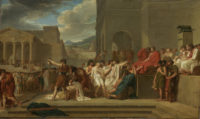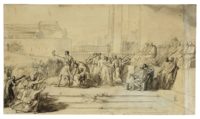 After seven months of conservation and more than two centuries of private ownership, Brutus Condemning His Sons to Death by Guillaume Guillon Lethière has gone on public display at the Clark Art Institute. The neoclassical painting depicts Lucius Junius Brutus, leader of the revolt against Lucius Tarquinius Superbus, the last king of Rome, and founder of the Roman Republic, stoically watching the execution of his sons for conspiring with the Tarquins to restore the monarchy. One son has already been decapitated and the executioner is holding the severed head aloft before the crowds.
After seven months of conservation and more than two centuries of private ownership, Brutus Condemning His Sons to Death by Guillaume Guillon Lethière has gone on public display at the Clark Art Institute. The neoclassical painting depicts Lucius Junius Brutus, leader of the revolt against Lucius Tarquinius Superbus, the last king of Rome, and founder of the Roman Republic, stoically watching the execution of his sons for conspiring with the Tarquins to restore the monarchy. One son has already been decapitated and the executioner is holding the severed head aloft before the crowds.
Lethière was born in 1760 in the French colony of Guadeloupe, the illegitimate son of government functionary Pierre Guillon and Marie-Françoise Pepayë, a mulatto former slave. His last name is actually a reference to his birth order. He was his father’s third illegitimate child. While Guillon would not officially recognize his son until 1799, he was very much involved in his life. The young Guillaume moved to France with his father when he was 14 and enrolled in the Academy of Rouen, a tuition-free art school founded by Jean-Baptiste Descamps. His talents were quickly recognized and in 1777 he enrolled at the Académie Royale in Paris in the studio of Gabriel François Doyen. He competed for the Prix de Rome twice and lost, but made such a strong impression with the wealthy, noble and connected Comte de Montmorin that the count secured him the pension and stay at the French Academy in Rome that the prize would have given him.
 It was in Rome, fittingly enough, that Lethière created Brutus Condemning His Sons to Death. He was a fervent neoclassicist by then, having eschewed Doyen’s Baroque style in favor of Jacques-Louis David’s integration of Enlightenment political principles in scenes from classical antiquity. Painted in 1788, Lethière’s vision of the Brutus story pre-dated David’s famed The Lictors Bring to Brutus the Bodies of His Sons by a year, and what a year was there, my friends. In 1789, the Bastille fell, the Declaration of the Rights of Man and of the Citizen was passed and feudalism was abolished. Even so, David’s far less gory version of the execution of the Brutus sons caused consternation among the authorities. They thought its vision of Republican honor against tyranny even at enormous personal cost might incite anti-monarchical passions. And there are no decapitated heads held proudly aloft in that one.
It was in Rome, fittingly enough, that Lethière created Brutus Condemning His Sons to Death. He was a fervent neoclassicist by then, having eschewed Doyen’s Baroque style in favor of Jacques-Louis David’s integration of Enlightenment political principles in scenes from classical antiquity. Painted in 1788, Lethière’s vision of the Brutus story pre-dated David’s famed The Lictors Bring to Brutus the Bodies of His Sons by a year, and what a year was there, my friends. In 1789, the Bastille fell, the Declaration of the Rights of Man and of the Citizen was passed and feudalism was abolished. Even so, David’s far less gory version of the execution of the Brutus sons caused consternation among the authorities. They thought its vision of Republican honor against tyranny even at enormous personal cost might incite anti-monarchical passions. And there are no decapitated heads held proudly aloft in that one.
David had already begun working on his masterpiece (it was 14 feet wide and took two years to complete) when Lethière finished his at the French Academy in Rome. The director of the Academy praised its emotional expressiveness in a letter, but if it was exhibited in public when it arrived in Paris that fall or thereabouts there is no record of it. It was definitely seen because German critic G.A. von Halem visited David’s studio during a trip to Paris in 1790 and compared the two works: “Lethière … showed the bloody head of one son. But one flees before blood and one suffers the double fear that the blood of the second son will be shed…. David has made the best choice. He has opted for the moment which follows the execution, and yet he has spared us the horrible sight of the place of execution.”
That horrible sight would become a common one when the Reign of Terror started in 1793. When it ended with Robespierre’s execution a year or so later, 17,000 people had been executed. That’s a lot of heads held proudly aloft. The year after that, Brutus Condemning His Sons to Death was exhibited in the Paris Salon of 1795. It was shown again in the Paris Salon of 1801. It elicited negative reviews both times; the explicit violence made people uncomfortable.
The painting would not be seen in public again for almost two hundred years until it was loaned for an exhibition dedicated to Guillaume Guillon Lethière in Point-à-Pitre, Guadeloupe, in 1991. After that it made two appearances at the Musée de la Révolution Française, one in 1992, one in 1996, and that’s it. In the 230 years since its creation, it has been exhibited for a grand total of six months. Now it is finally on display for good.